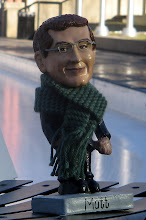Last night we performed new music by Marc-Andre Dalbavie, Henri Dutilleux, and Wolfgang Rihm - probably not as big household names as Peyton Manning or Rex Grossman, but all still worth a listen. It's been interesting this week, practicing some rather severe, demanding music, while throngs of people all around South Beach party and celebrate football. As might be expected, our concert wasn't especially crowded. Not to judge our Super Bowl guests too harshly, but they probably aren't big contemporary music fans, while those who might have come had to face massive traffic and parking nightmares. So the barriers were pretty high, and the audience, as small as it was, seemed especially devoted.
They heard a spectacular performance from Barbara Hannigan, singing a beautiful setting of letters by Dutilleux, Correspondances. Dutilleux recently turned 91, and part of his longevity might be constantly setting challenges for himself - when we connected to him via Internet 2 in Paris, he insisted on speaking in fractured English, even as our conductor Reinbert de Leeuw tried to switch him over to French. His grammar, like the sonorities in his music, twists and turns between novel, puzzling, and delightful - always there is the sense of a searching imagination at play.
The other two pieces, Dalbavie's Color and Rihm's Two Other Movements, were not lacking in imagination either. Besides the obvious meaning, 'color' also signifies a practice common in medeival music, in which parts were layered and into overlapping melodic and rhythmic structures, called 'color' and 'talea'. It's one of those curious cul-de-sacs in music history, which long ago went out of style, only preserved in trivia and musicology courses, then modern composers like Messiaen and Dalbavie found new uses and brought it back to life in their music. There was a sense in Dalbavie's piece of music unfolding across different strata of time, freed from rigid bar lines even as the individual parts follow a careful logic.
So much new music can seem aimless - unlike football, we're not sure what the rules are, in what way they're being observed or stretched, or when the whole thing is likely to end. That was the case for me in the Rihm piece, which I found alternately fascinating and insufferable. (I try to be an advocate for the music while I'm playing it, but afterwards you can be ambivalent, right?) I honestly wasn't sure how it held together, and I was worried the audience's attention and patience might wander through the 40 minutes or so that it lasted. Still, the performance kept up a certain steady intensity, and I found I liked the whole thing better than I'd thought.
It's funny, even as music becomes easier to package, access, and consume, I think it sometimes becomes harder to really listen to it. I've listened to more music lately than ever before, on my iPod or stereo, but I surely forget, tune out, or miss more than I catch. Walking down Washington Avenue, trying to listen to a Corigliano Symphony, is like trying to catch water in your hands, with a bus bearing down from behind! In a certain way, I think we've returned (if we ever left it) to a time in which the concert hall is the only place this music can really live and breathe, and recordings can give only a vague suggestion. What once was practically impossible, hearing a symphony at any time, is now easy enough in theory. But for me anyway, the distractions always win out, and I'm left with the same old necessities: a concert hall, a live orchestra, an audience of fellow listeners - just like the composers intended.
Subscribe to:
Post Comments (Atom)


 Technorati Link Count: no. of blog reactions to this post
Technorati Link Count: no. of blog reactions to this post
1 comment:
You're really right on about the paradox of hearing more and listening less with the influx of the ipod and all its brethren. I think that for me there's a strong pull to sit in a hall and listen to live music to counteract all the passive hearing of background music and noise. Too bad I don't actually get to do it more....
Post a Comment